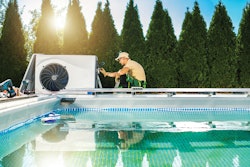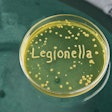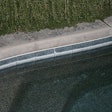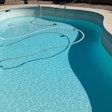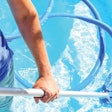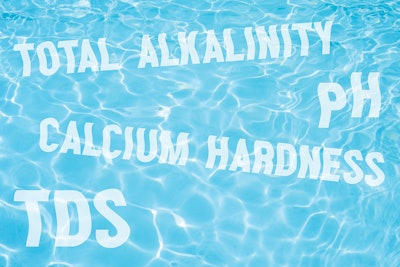
Proper water chemistry is the key to good water quality. One of the first and foremost aspects of water chemistry is to know the make-up of the source water used to fill the pool or hot tub. Complete testing of the water from the source before filling a pool is recommended in order to properly treat a newly filled pool or hot tub; additionally, knowing these values can help diagnose issues that may arise in the future.
There are numerous water quality issues that can arise from source water. For instance, water typically comes in three types: hard, soft and somewhere in between. Soft water is water with extraordinarily little mineral content. The introduction of low mineral water into a plaster or aggregate pool could lead to the destruction of cementitious surfaces, tile grout and metal materials found in pumps, heaters, plumbing and valves. Hard water refers to water that is over-saturated with dissolved solids, such as calcium and metals, which can lead to the precipitation of damaging scale and stains on surfaces.
Effectively managed water with good water chemistry provides more optimal disinfection. It also ensures better protection of pool system equipment and the pool surfaces. Most importantly, the feel and comfort of the water for swimmers will be more enjoyable. Since properly sanitized water is a primary aspect of pool maintenance, following correct water quality standards is paramount. The components of water chemistry include:
- Total alkalinity
- pH
- Calcium hardness
- Total Dissolved Solids (TDS)
Total alkalinity — Total alkalinity is the factor that tells you a solution’s ability to resist a change in pH. It is a key component of pool, hot tub and spa water chemistry. When total alkalinity is properly maintained, pH, sanitizer efficacy, water clarity and swimmer comfort are more easily maintained. Alkalinity exists primarily in these forms: carbonate, bicarbonate, hydroxyl, and, if used, cyanuric acid. At pH values in swimming pools, the majority of alkalinity exists in the bicarbonate form.
In the APSP-11 Standard, the recommended range for total alkalinity is 60 ppm to 180 ppm. If total alkalinity is too low, then pH will tend to fluctuate rapidly from high to low; this is defined as pH bounce. Low alkalinity can also lead to etching of the plaster or aggregate, often discoloring surface walls, and destruction of metal heat exchangers. High total alkalinity can cause “pH lock,” a term that refers to water that is more difficult to lower in pH using chemicals. High total alkalinity can also cause cloudy water, rough pool or hot tub surfaces from scale, clogged filters and heaters, and poor circulation.
Maintaining the total alkalinity between 60 ppm and 180 ppm avoids the excessive use of chemicals required for proper water chemistry. By acting as a buffer for pH, it also allows for the use of common sanitizers, such as chlorine and bromine, with an infrequent need to compensate for the pH of these chemicals. Since pool water is open to the air, carbon dioxide (CO2) is constantly being released from the water into the air. Over time, this will lower the carbonate/bicarbonate component of alkalinity. Therefore, total alkalinity levels should be checked regularly to ensure sufficient buffer is present. In most cases of new, freshly filled pools, the first water parameter to address is the alkalinity.
pH — pH is a measure of the concentration of hydrogen ions in the water. Increasing the concentration of hydrogen ions in the pool water will lower the pH since acids are sources of hydrogen ions. pH should be maintained between 7.2 and 7.8, and pH changes over time should be minimal. Any type of feature (such as waterfalls, spillways, fountains, a high-negative edge, etc.) that leads to aeration and turbulence of the water will cause an increase in the pH due to off-gassing of CO2. Often, slightly lowering the alkalinity level within the recommended range will moderate the upward drift of pH and vice versa. Hydrochloric acid, also known as muriatic acid, is commonly used in the pool industry to control the pH of recreational water. Another commonly used acid is sodium bisulfate. Sodium bisulfate is a dry, mineral acid that is stable in a dry environment but will quickly dissolve when added to water.
Regarding pH and chlorine effectiveness, it is vital to manage the pH within range as increasing pH will lead to a decrease in proper disinfection from chlorine. This is because hypochlorous acid is a more effective sanitizer than the hypochlorite ion and, at lower pH values, there is more hypochlorous acid. A pool with a temperature of 86 degrees Fahrenheit, 0 ppm cyanuric acid and a pH of 7.5 will have 49.84% of the chlorine present as HOCl. Under the same conditions and a pH of 8.0, the percentage of chlorine as HOCl goes down to just 23.91%.
Calcium Hardness — Calcium is a mineral commonly found in source water. The ideal range for calcium (measured as calcium hardness) should be between 200 to 400 ppm, with an absolute minimum value of 150 ppm and a recommended maximum value of 1000 ppm. Calcium chloride is used to raise the level of calcium. Calcium hardness that is too low may lead to corrosive water, etching of pool surface and possible heater failure. High calcium hardness may cause scale formation on surfaces and equipment, cloudy water, clogged filters and reduced circulation and eye and skin irritation of swimmers.
Total Dissolved Solids (TDS) — Total Dissolved Solids (TDS) need to be monitored and tested regularly, at least every three months. Whenever testing for TDS, compare the existing level to that obtained at initial startup (including the addition of salt, if used). If the TDS level is 1500 ppm over the startup level, a drain and dilution of the pool is recommended. This should be done to bring the pool water as close to the original level as possible. Elevated levels of TDS frequently indicate high levels of organic content, nuisance chloramines, and other contaminants that chlorine is no longer able to effectively eliminate. Elevated TDS causes chemicals to be less effective and leads to hazy and cloudy water conditions. Very high TDS levels can lead to high conductivity in the pool water, resulting in the damaging corrosion of metal parts. The best and most cost-efficient way to manage TDS and chemical use is to develop a program of planned water replacement. Smaller amounts of water are drained either weekly, or even daily, and replaced with fresh water. This process allows for the more efficient use of all chemicals, including the sanitizer, thereby making the pool, hot tub or spa easier to maintain.
Water Balance Indexes — There are several water balance indexes used by the industry as tools to predict whether pool, hot tub and spa water tends to be scale forming or aggressive. These indexes should not be used to assess the level of proper sanitizing or swimmer health and safety. It should also be noted that these indexes do not necessarily predict the corrosion of steel and other metals, as they fail to account for several other corrosion factors. Moreover, water chemistry parameters are constantly changing and there is no steady state or equilibrium in saturation chemistry. As such, these indexes should be used only as predictive tools to anticipate general tendencies of the water. For more information on water balance indexes, please refer to the PHTA Water Balance Indexes Fact Sheet.
CONCLUSION
Proactive water chemistry management, by maintaining pH, alkalinity, and calcium hardness close to the ideal levels and developing a practical routine of draining and diluting water to manage TDS levels, will ensure the highest quality of pool, hot tub and spa water. This will protect pool surfaces and equipment, and make the experience of swimming more pleasant for users.
REFERENCES
1. ANSI/APSP/ICC-11 2019 American National Standard for Water Quality in Public Pools and Spas, Pool & Hot Tub Alliance
2. CPO Pool and Spa Operator Handbook, Pool & Hot Tub Alliance, 2022
3. Service Tech Manual, Version 5.1, Pool & Hot Tub Alliance, 2019
4. White’s Handbook of Chlorination and Alternative Disinfectants, 5th Edition, John Wiley & Sons
5. PHTA Source Water Fact Sheet, Pool & Hot Tub Alliance
6. PHTA Water Balance Indexes Fact Sheet, Pool & Hot Tub Alliance
7. PHTA Alkalinity Fact Sheet, Pool & Hot Tub Alliance
This article first appeared in the May 2023 issue of AQUA Magazine — the top resource for retailers, builders and service pros in the pool and spa industry. Subscriptions to the print magazine are free to all industry professionals. Click here to subscribe.

























